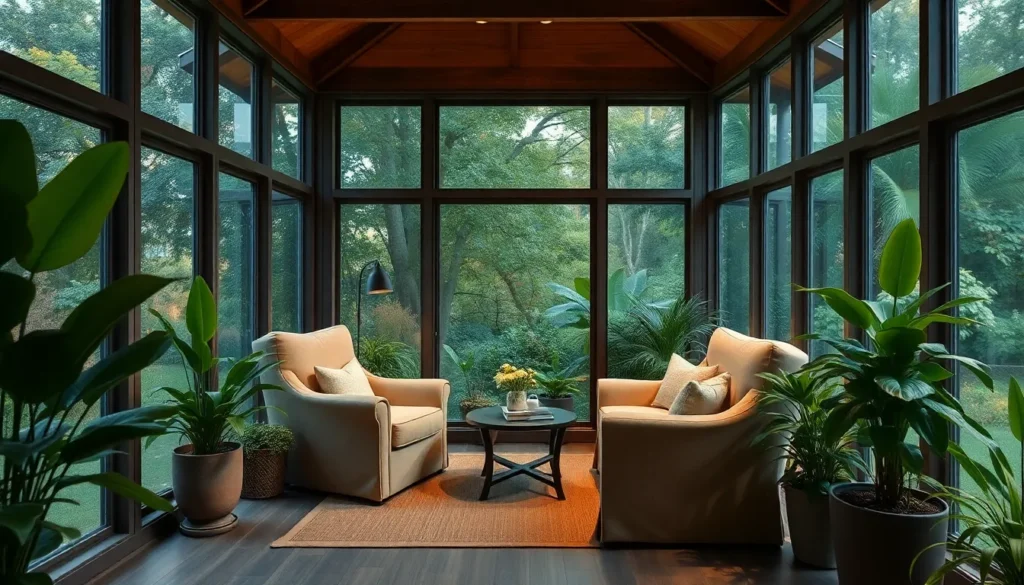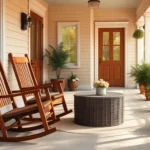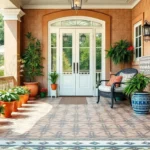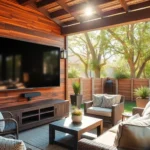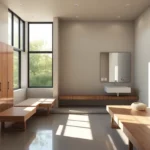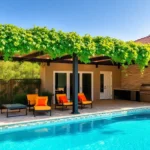Transforming your back porch into a closed-in sanctuary opens up endless possibilities for year-round enjoyment and added living space. We’ve all dreamed of having that perfect retreat where we can relax with morning coffee regardless of weather conditions or create an entertaining space that seamlessly blends indoor comfort with outdoor charm.
A closed-in back porch isn’t just an addition – it’s an investment that dramatically increases your home’s value while expanding your usable square footage. Whether you’re working with a small budget or planning a complete renovation we’ll show you how to maximize every inch of space with smart design choices and creative answers.
From cozy reading nooks and dining areas to home offices and seasonal rooms the potential for your enclosed porch is limitless. We’ve gathered the most inspiring and practical ideas that’ll help you create a space that perfectly matches your lifestyle and enhances your home’s overall appeal.
Transform Your Back Porch Into a Cozy Sunroom Retreat
Converting your enclosed back porch into a sunroom creates an inviting space that bridges indoor comfort with outdoor beauty. We’ll show you how strategic design elements can maximize natural light and create a peaceful retreat that you’ll use throughout the year.
Install Floor-to-Ceiling Windows for Natural Light
Floor to ceiling windows maximize sunlight exposure while creating an open, airy atmosphere in your converted sunroom. Large glass panels spanning from floor to ceiling eliminate visual barriers and flood the space with natural illumination. We recommend double pane or triple pane windows for better insulation and energy efficiency.
Position windows on multiple walls to capture light throughout the day. South facing windows provide consistent warmth and brightness, while east and west facing installations offer ever-changing lighting that changes with the sun’s movement. Corner window configurations create dramatic visual impact and enhance the indoor outdoor connection.
Consider different window styles based on your ventilation needs and aesthetic preferences. Casement windows offer excellent airflow control, while fixed picture windows maximize uninterrupted views. Sliding glass doors can replace traditional walls to create seamless transitions between your sunroom and outdoor spaces.
Add Comfortable Seating and Soft Furnishings
Comfortable seating arrangements form the foundation of your sunroom’s relaxation potential. Deep cushioned sofas, oversized armchairs, and chaise lounges invite extended lounging sessions while withstanding temperature fluctuations. We suggest weather resistant fabrics like solution dyed acrylics or indoor outdoor blends that resist fading and moisture damage.
Layer soft furnishings to create visual warmth and tactile comfort throughout the space. Throw pillows in coordinating colors add personality and seasonal flexibility, while lightweight blankets provide cozy options for cooler evenings. Area rugs define seating zones and introduce pattern or texture that complements your overall design scheme.
Include versatile furniture pieces that serve multiple functions in your sunroom layout. Storage ottomans provide hidden organization while doubling as extra seating or footrests. Accent tables offer surfaces for beverages, books, and decorative objects without overwhelming the open feel of the space.
Incorporate Plants for a Garden Room Feel
Indoor plants transform your sunroom into a lush garden retreat that thrives in abundant natural light. Large floor plants like fiddle leaf figs, monstera deliciosa, or bird of paradise create dramatic focal points and natural privacy screens. We recommend selecting plants based on your sunroom’s exact light conditions and temperature ranges.
Create layered plant displays using stands, hanging planters, and wall mounted systems. Trailing plants like pothos or string of hearts add vertical interest when suspended from ceiling hooks or placed on tall plant stands. Grouping plants of varying heights and textures creates visual depth and mimics natural garden compositions.
Choose low maintenance plant varieties that flourish in sunroom environments without constant attention. Succulents, snake plants, and ZZ plants tolerate temperature variations and occasional watering lapses. Herbs like basil, rosemary, and mint provide aromatic benefits while serving practical culinary purposes in your garden room oasis.
Create a Functional Home Office Space
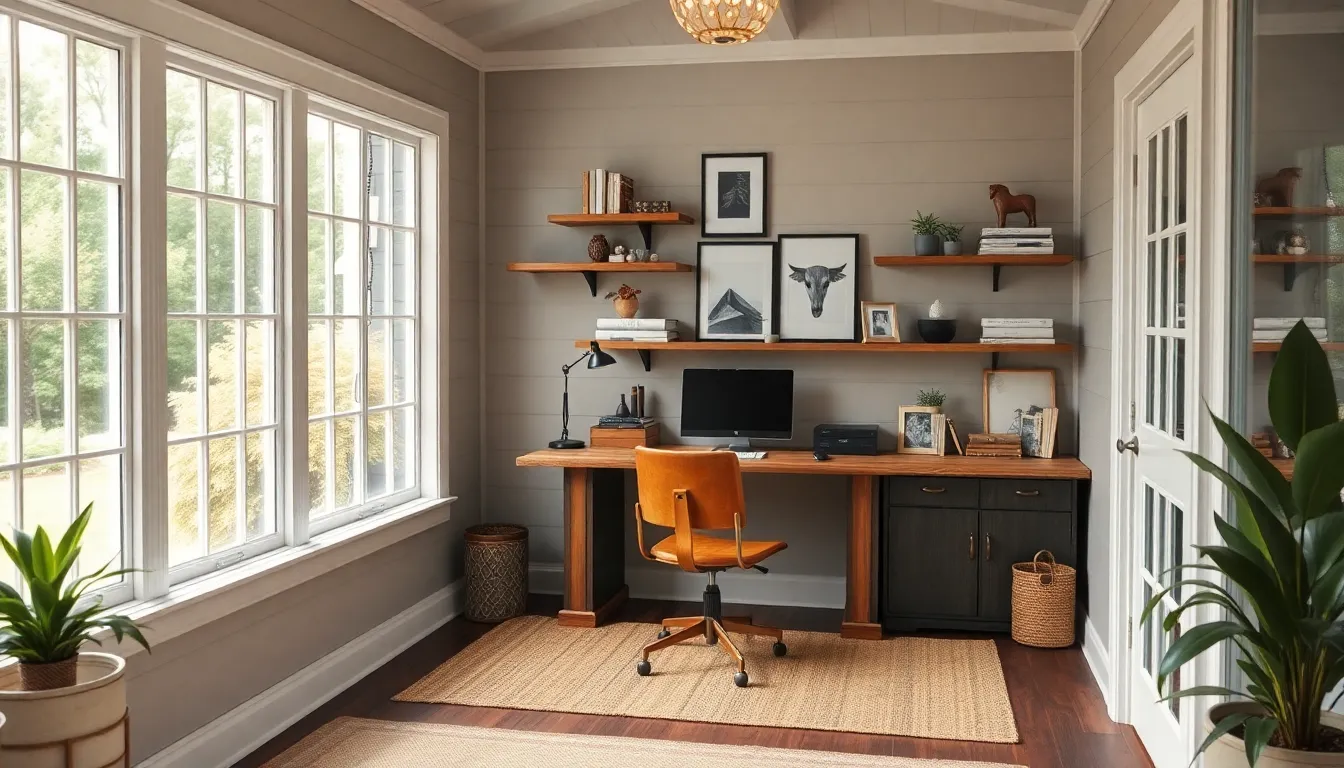
Converting your enclosed back porch into a home office maximizes underutilized space while adding important value to your property. We recommend integrating this office seamlessly with your home’s existing style by matching molding and trim details or opening doorways to adjacent rooms.
Set Up a Dedicated Work Station
Building a custom desk with ample workspace becomes the foundation of our productive porch office setup. Positioning this workstation near large windows harnesses natural light that enhances mood and boosts daily productivity levels. We suggest incorporating built in niches or shelving nearby to display artwork or store frequently accessed items while maintaining our clutter free environment.
| Workstation Element | Recommended Specifications |
|---|---|
| Desk Surface Area | Minimum 60 inches wide x 30 inches deep |
| Window Proximity | Within 3-5 feet for optimal natural light |
| Built-in Storage | 2-3 shelves or niches per workstation |
Ensure Proper Lighting and Electrical Outlets
Installing multiple lighting layers creates the ideal work environment beyond natural window light. Task lighting through adjustable desk lamps or ceiling fixtures reduces eye strain during long work sessions. We position electrical outlets and USB ports strategically around the workspace to power computers, printers, and charging devices without relying on unsightly extension cords.
Proper electrical planning includes outlets every 6 feet along walls plus dedicated circuits for high power equipment. Dimmer switches on overhead lighting allow us to adjust brightness throughout different times of day.
Add Storage Answers for Office Supplies
Incorporating diverse storage options keeps our porch office organized and functional for daily use. Custom cabinets, drawers, and wall mounted organizers maximize vertical space while maintaining easy access to supplies. We design storage answers directly into desk structures or surrounding walls to optimize square footage efficiency.
Smart storage placement includes filing cabinets within arm’s reach of our workstation and supply organizers at eye level for quick identification. Built in storage maintains the clean aesthetic that helps us stay focused and productive in our converted porch office space.
Design a Relaxing Reading Nook and Library
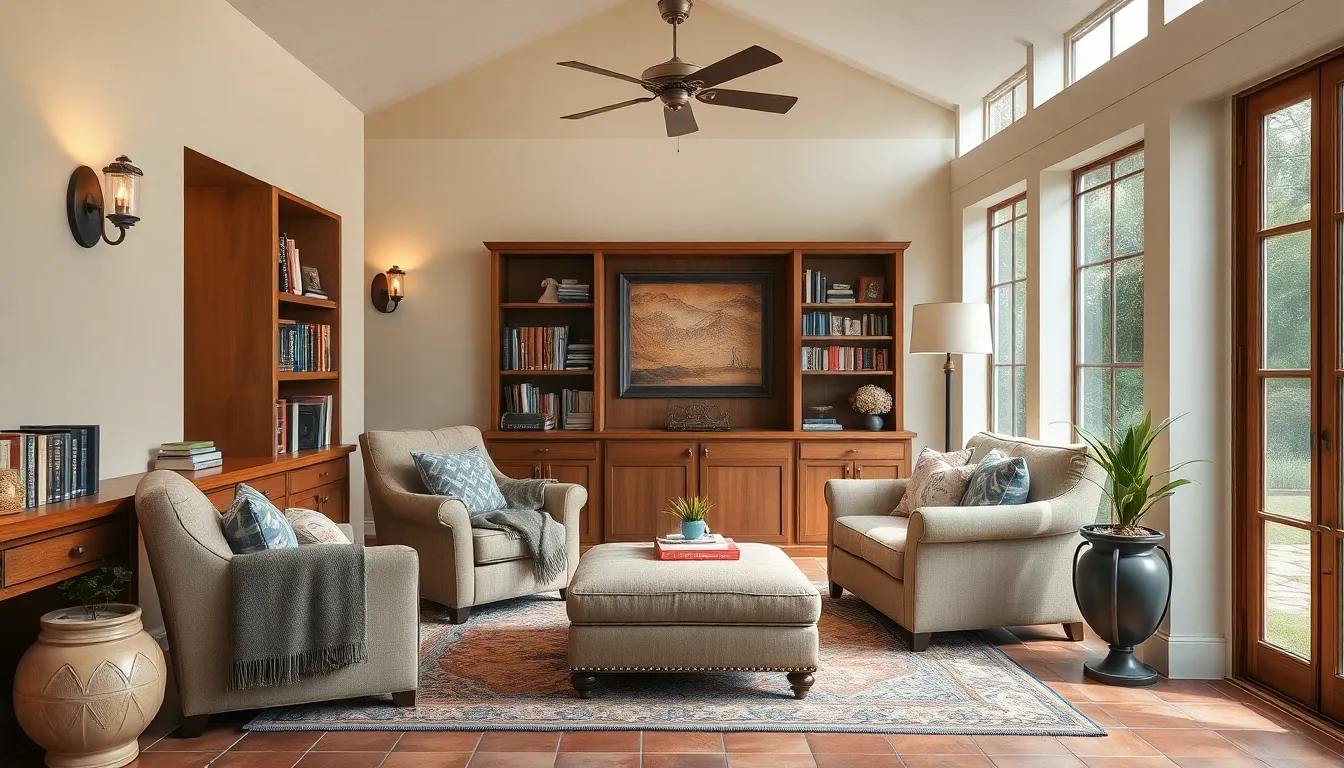
Transforming your enclosed back porch into a literary sanctuary creates the perfect balance between privacy and connection to nature. We’ll guide you through creating a personalized reading retreat that combines custom storage answers with ultimate comfort.
Build Custom Bookshelves Along the Walls
Custom bookshelves maximize every inch of your enclosed porch while creating an impressive library atmosphere. Built-in shelving units extend from floor to ceiling, utilizing vertical space that would otherwise remain unused. We recommend installing shelves at varying heights to accommodate different book sizes, decorative items, and personal collections.
Consider incorporating Mediterranean tile floors or warm wood tones to complement your custom bookcases. These architectural elements create a cohesive design that feels intentional rather than improvised. Storage becomes both functional and beautiful when you display favorite books alongside plants, artwork, and meaningful objects.
Fixed shelving units provide stability for heavy book collections while maintaining clean lines throughout the space. We suggest building shelves with depths between 8-12 inches to accommodate most book sizes without overwhelming the room’s proportions.
Include a Comfortable Reading Chair and Ottoman
Reading chairs become the focal point of your enclosed porch library when positioned strategically near windows. We recommend selecting oversized armchairs with plush cushioning that supports extended reading sessions. Pair your main chair with a matching ottoman to create a complete lounging experience.
Position your reading furniture to take advantage of natural light while maintaining privacy from neighboring properties. Comfortable textiles like soft throws and accent pillows enhance the cozy atmosphere while providing practical warmth during cooler months. We suggest choosing weather-resistant fabrics that can withstand temperature fluctuations in enclosed porches.
Ottoman placement allows you to elevate your feet while reading, reducing strain during long sessions. Consider storage ottomans that double as hidden compartments for extra blankets, magazines, or seasonal reading materials.
Add Soft Lighting for Evening Reading Sessions
Soft lighting transforms your enclosed porch reading nook into a usable space throughout the day and evening. Layer different light sources including floor lamps, table lamps, and wall sconces to create ambient illumination that reduces eye strain. We recommend warm bulbs with temperatures between 2700K-3000K for the most comfortable reading experience.
Wall sconces mounted near your reading chair provide directed task lighting without taking up valuable floor space. Floor lamps positioned behind or beside seating areas eliminate harsh shadows while maintaining the cozy atmosphere you’ve created. Table lamps on side tables or built-in shelves add intimate pools of light throughout the space.
Consider installing dimmer switches to adjust lighting levels based on time of day and reading preferences. Multiple light sources ensure you can customize the ambiance whether you’re reading during bright afternoons or quiet evening hours.
Establish an Indoor Dining Area Extension
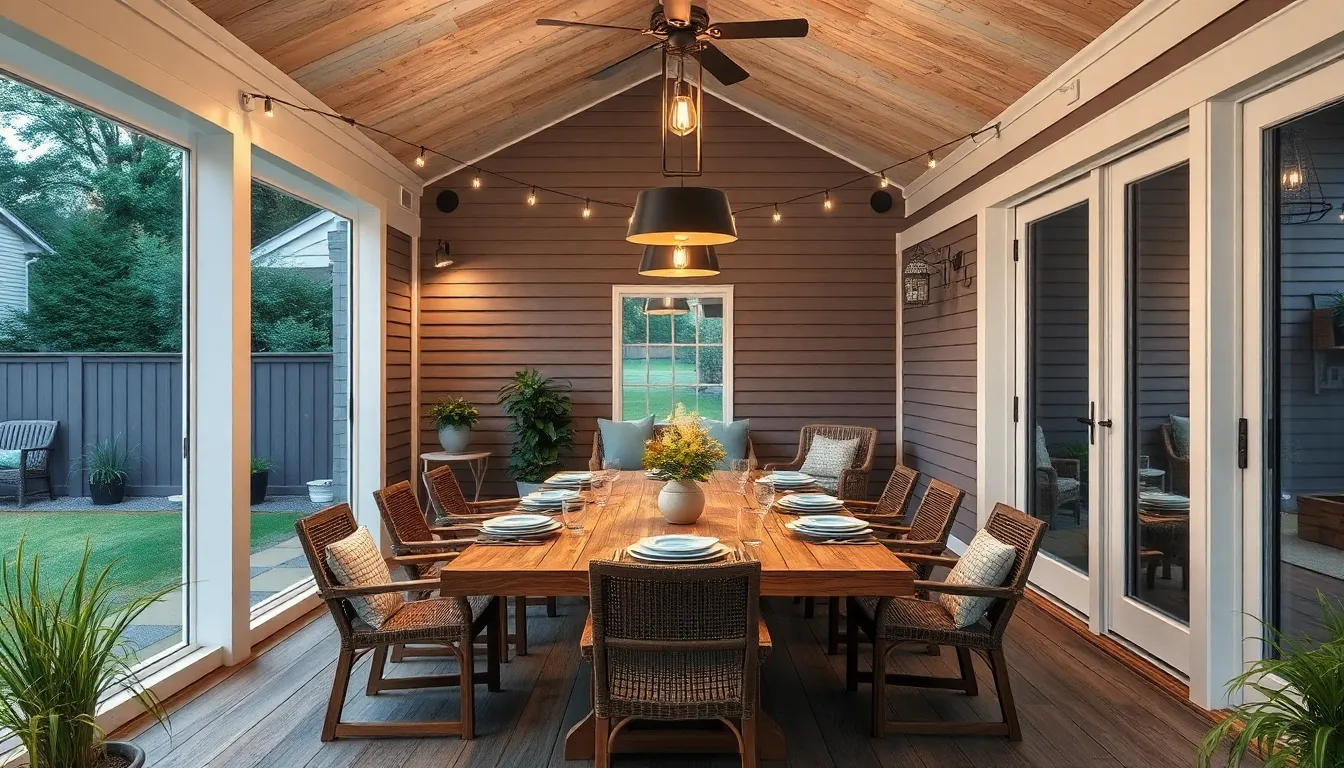
Creating an indoor dining extension transforms your enclosed back porch into a versatile space that bridges the gap between your kitchen and outdoor living. We can design this area with sliding or French doors that connect seamlessly to your home’s interior, making meal service effortless while maintaining that coveted outdoor atmosphere.
Install Weather-Resistant Flooring Options
Weather-resistant flooring forms the foundation of a successful enclosed dining porch that withstands moisture and temperature fluctuations year-round. Porcelain and ceramic tiles offer the perfect solution, resembling traditional indoor floors while enduring outdoor conditions with remarkable durability. Composite decking provides another excellent choice, delivering both style and functionality for spaces that experience heavy foot traffic during dinner parties and family gatherings.
Sealed concrete floors create a modern aesthetic that’s incredibly easy to maintain, protecting against spills and dirt that naturally occur in dining areas. These flooring materials ensure your dining extension remains beautiful and functional regardless of weather conditions or seasonal changes.
Choose Durable Furniture for Year-Round Use
Durable furniture selection ensures your dining extension remains comfortable and attractive through all seasons, even when the space isn’t fully climate controlled. Treated wood pieces offer timeless appeal while resisting humidity and temperature variations that can damage traditional indoor furniture. Synthetic wicker furniture provides the classic outdoor dining look with enhanced durability, featuring weather-resistant fibers that maintain their appearance year after year.
Aluminum and steel frame pieces with water-resistant cushions deliver exceptional longevity while supporting diverse activities from casual breakfast to formal dinner parties. These materials withstand sun exposure and humidity fluctuations, ensuring your investment continues to serve your family’s dining and entertaining needs throughout the seasons.
Add Ambient Lighting for Dinner Parties
Ambient lighting creates the perfect atmosphere for memorable dinner parties and intimate family meals in your enclosed dining extension. Pendant lamps and outdoor-rated chandeliers provide essential overhead illumination while adding visual interest to your dining space. Sconces mounted on walls deliver softer accent lighting that complements your primary light sources, creating layers of illumination that enhance the dining experience.
String lights add magical ambiance for evening gatherings, while dimmable LED bulbs with warm color temperatures create that cozy restaurant-quality atmosphere at home. Ceiling fans with integrated lighting fixtures serve dual purposes, providing both comfort and illumination while maintaining the space’s functionality for year-round entertaining.
Develop a Multi-Purpose Family Room
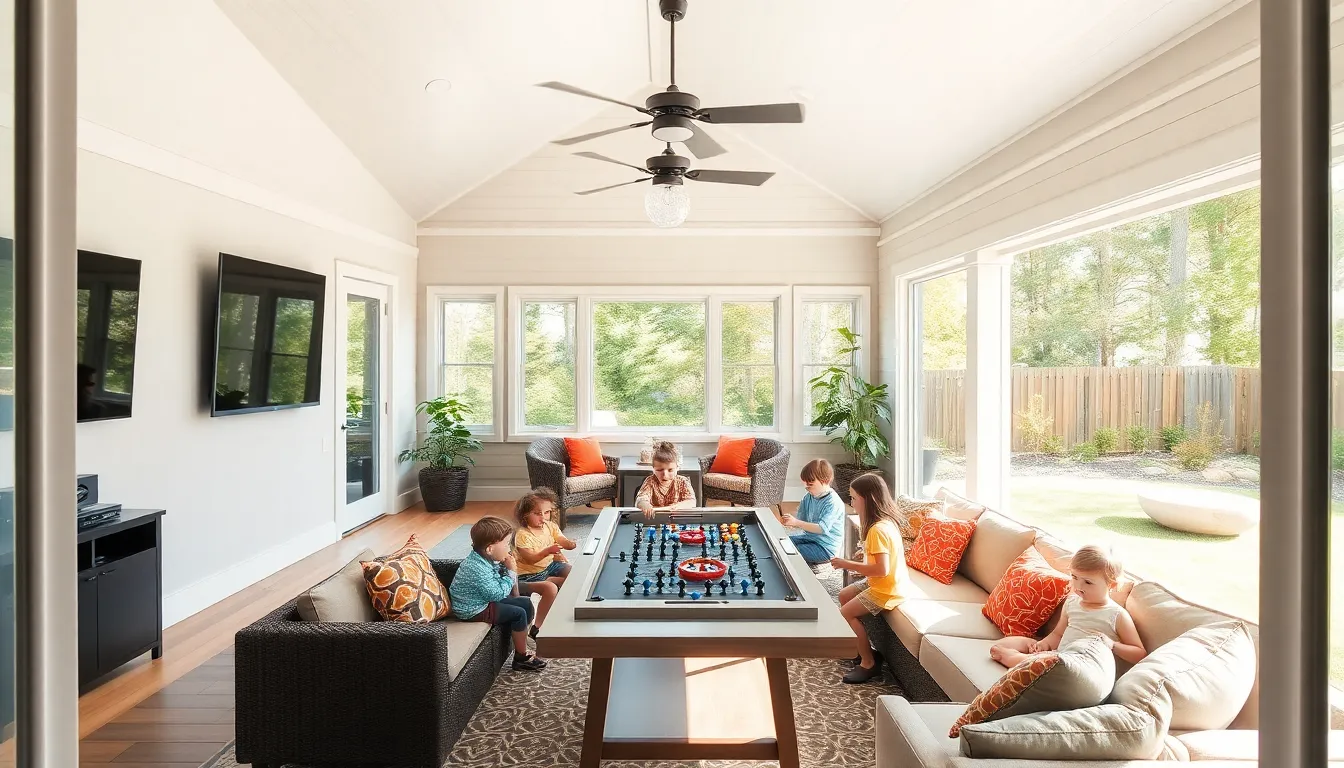
Converting your enclosed back porch into a multi-purpose family room creates a versatile gathering space that adapts to various activities throughout the year. This transformation combines indoor comfort with outdoor charm, making it perfect for family entertainment and daily activities.
Incorporate Entertainment Systems and Media Storage
Installing a TV or projector setup transforms your enclosed porch into an entertainment hub where families can enjoy movies, sports, and gaming sessions together. We recommend mounting a 55-inch or larger TV on the wall to maximize floor space while providing optimal viewing for multiple family members.
Built-in shelving and cabinets offer practical media storage answers that keep gaming consoles, DVDs, and electronics organized and easily accessible. Custom entertainment centers blend seamlessly with your porch’s design while providing dedicated spaces for streaming devices, sound systems, and cable management.
Strategic placement near large windows allows you to enjoy natural light during daytime viewing while maintaining clear sightlines to your garden and outdoor spaces. Evening entertainment becomes more immersive with proper window treatments that reduce glare and create a theater-like atmosphere when needed.
Add Flexible Seating for Different Activities
Modular sofas provide the foundation for versatile seating arrangements that easily reconfigure for different family activities and group sizes. Sectional pieces move independently, allowing you to create intimate conversation areas or open spaces for larger gatherings and game nights.
Armchairs and ottomans complement modular seating by offering additional comfort options that serve multiple purposes throughout the day. These pieces work perfectly for reading sessions, casual dining, or providing extra seating when entertaining guests.
Foldable chairs and lightweight benches store conveniently when not in use while providing instant seating answers for unexpected visitors or special occasions. Weather-resistant fabrics ensure durability against humidity and temperature fluctuations common in enclosed porch environments.
Comfortable cushions in outdoor-rated materials maintain their appearance and comfort level through seasonal changes while adding color and texture to your family room design.
Include Game Tables and Children’s Play Areas
Dedicated game tables create interactive zones where both kids and adults can enjoy foosball, table tennis, board games, and card tournaments together. We suggest choosing tables with storage compartments underneath to keep game pieces, paddles, and accessories organized and protected.
Children’s play areas with built-in storage answers encourage creative activities while maintaining a clutter-free environment for the entire family. Custom cubbies and toy chests blend with your porch’s aesthetic while providing designated spaces for create supplies, building blocks, and educational materials.
Activity stations positioned near natural light sources create ideal conditions for assignments sessions, art projects, and puzzle solving during daytime hours. These areas transition seamlessly from children’s activities to adult hobbies like scrapbooking or model building.
Safety considerations include rounded table corners, non-slip rugs, and adequate spacing between play areas and seating zones to prevent accidents during active play sessions.
Build a Craft Room and Creative Studio
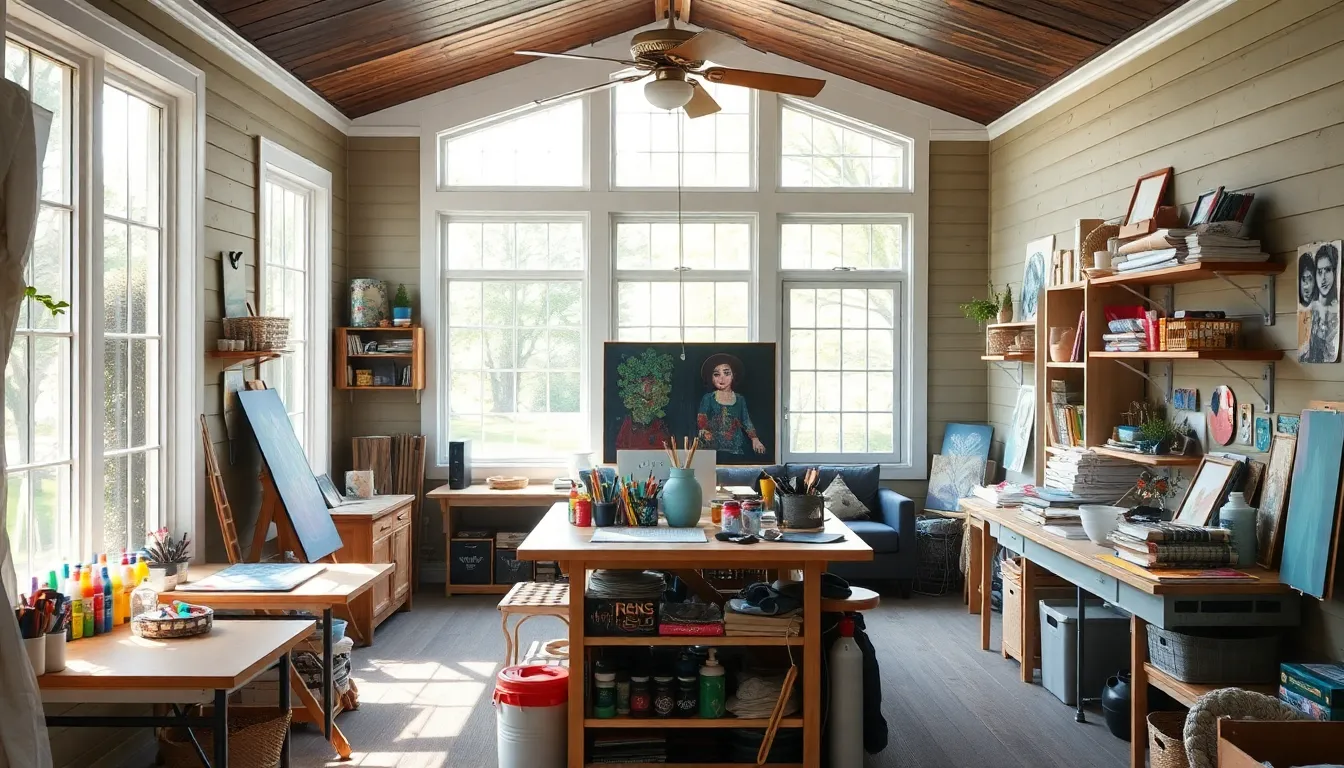
Transform your enclosed back porch into a dedicated create room and creative studio where artistic pursuits flourish year round. We’ll explore the essential elements that make this space both functional and inspiring for your creative endeavors.
Install Adequate Task Lighting and Ventilation
Proper lighting forms the foundation of any successful create room since detailed work requires excellent visibility. We recommend combining natural light from existing windows with bright task lighting such as adjustable LED lamps to illuminate intricate projects effectively. Position multiple light sources at different angles to eliminate shadows and provide consistent illumination across your workspace.
Ventilation keeps the air fresh and safe when you’re working with paints, glues, or other materials that produce fumes. Installing a ceiling fan helps maintain consistent airflow throughout the space while operable windows provide natural ventilation on pleasant days. Consider adding an exhaust fan if you frequently work with strong adhesives or spray materials to ensure proper air circulation.
Add Built-In Storage for Create Supplies
Custom storage answers maximize your enclosed porch’s limited footprint while keeping supplies organized and accessible. Build floor to ceiling shelves along available walls to house fabric collections, paper storage, and reference materials efficiently. Incorporate drawers of various sizes to accommodate different supply types from small beads and buttons to larger tools and equipment.
Vertical storage systems work particularly well in narrow porch spaces where floor area is at a premium. Use labeled bins and clear containers to identify supplies quickly while maintaining a clean aesthetic. Consider pull out drawers in lower cabinets for easy access to frequently used materials without requiring you to bend or reach uncomfortably.
Include Work Surfaces at Different Heights
Multiple work surfaces at varying heights provide ergonomic options for different create activities and body positions. Create a large central island or install modular tables that adapt to sewing, painting, drawing, or other specialized tasks throughout your creative sessions. Standing height counters work excellently for cutting fabric or paper while seated desk heights accommodate detailed work like jewelry making or model building.
Adjustable height tables offer the ultimate flexibility for create rooms where multiple people or various activities require different working positions. Position these surfaces near windows to take advantage of natural light while ensuring adequate electrical outlets nearby for tools and equipment. Consider adding casters to portable work surfaces so you can reconfigure your space based on current projects or group activities.
Install Proper Insulation and Climate Control
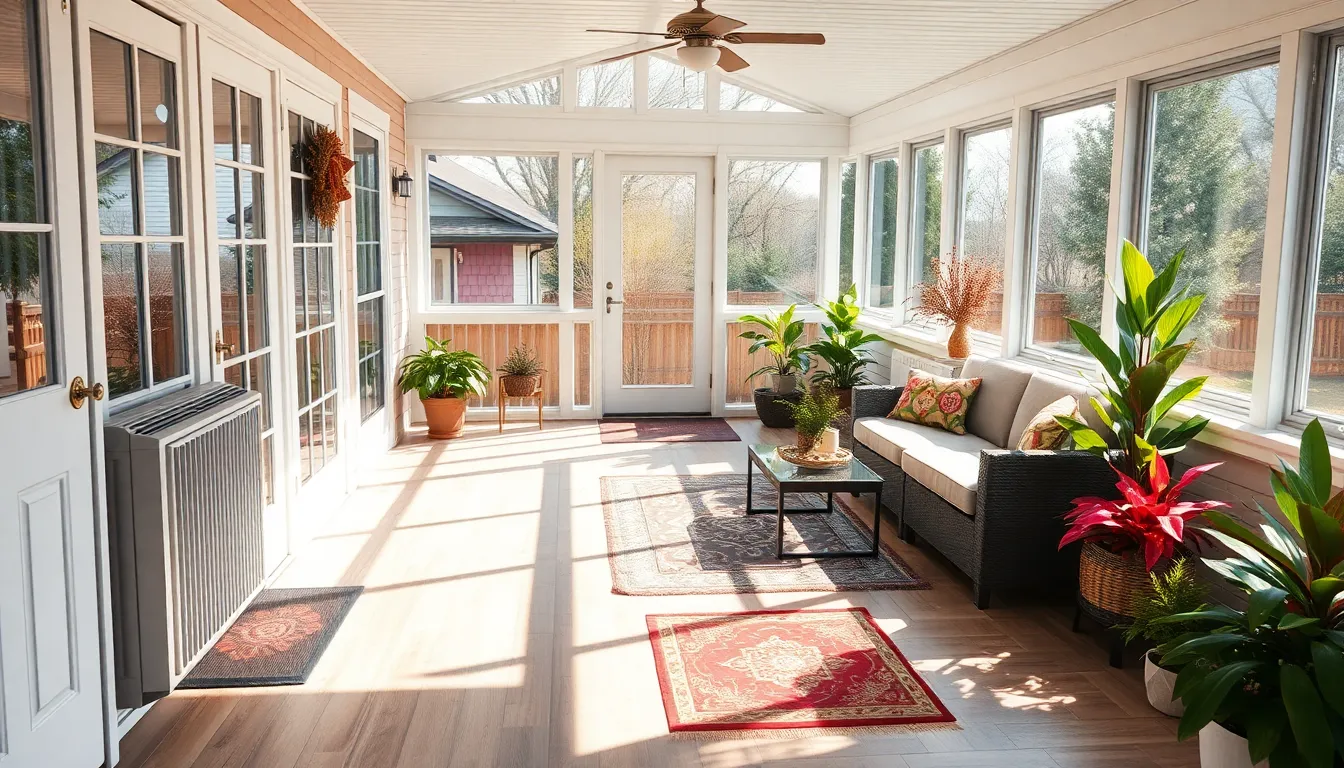
Proper insulation transforms your enclosed back porch into a comfortable space you’ll use throughout every season. Temperature control becomes achievable when we address insulation gaps that cause energy loss and uncomfortable drafts.
Choose Energy-Efficient Heating and Cooling Options
Energy-efficient heating systems reduce operating costs while maintaining consistent comfort levels in your enclosed porch space. Heat pumps offer excellent performance for moderate climates, providing both heating and cooling functions with lower energy consumption than traditional electric baseboard systems. We recommend ductless mini-split units for their zone control capabilities and quiet operation.
Electric baseboard heating remains popular for smaller porch conversions, though continuous operation occurs when insulation proves insufficient. Programmable thermostats paired with Energy Star rated heaters maximize efficiency by adjusting temperatures based on usage patterns. Ceiling fans complement any heating system by circulating warm air and reducing hot spots near windows.
Natural ventilation through operable windows or sliding glass wall systems like NanaWall reduces mechanical cooling dependency during mild weather. We suggest combining passive cooling strategies with active systems to create the most cost-effective climate control solution.
Add Weatherproofing and Moisture Control
Weatherproofing prevents moisture infiltration that damages insulation and creates uncomfortable humidity levels in enclosed porch spaces. Sealing techniques include applying weatherstripping around doors and windows, caulking gaps with weatherproof mastic, and addressing structural joints where air leakage commonly occurs.
Moisture control requires proper drainage systems and materials resistant to mold and mildew growth. We install vapor barriers behind wall insulation to prevent condensation buildup during temperature fluctuations. Ventilation fans help remove excess humidity from cooking or plant watering activities.
Double-paned glass windows reduce condensation formation while maintaining clear views throughout seasonal weather changes. Proper flashing around window frames and door installations prevents water penetration that compromises structural integrity over time.
Select Appropriate Flooring for Temperature Changes
Flooring materials must withstand temperature fluctuations without warping, cracking, or separating at joints in enclosed porch environments. Insulated vinyl planks provide comfort underfoot while resisting moisture and temperature-related expansion. Ceramic tiles offer durability and easy maintenance, though they feel cold during winter months without radiant heating systems.
Treated wood designed for exterior applications handles seasonal changes better than standard indoor flooring options. We avoid materials prone to moisture absorption like bamboo or untreated hardwood that buckle under humidity variations. Composite materials engineered for outdoor use maintain stability across temperature ranges while providing attractive wood-like appearance.
Area rugs add warmth and comfort during cooler months while protecting underlying flooring from furniture scratches. Removable floor coverings allow seasonal decoration changes and easier deep cleaning when transitioning between outdoor and indoor usage patterns.
Select Durable Materials and Finishes
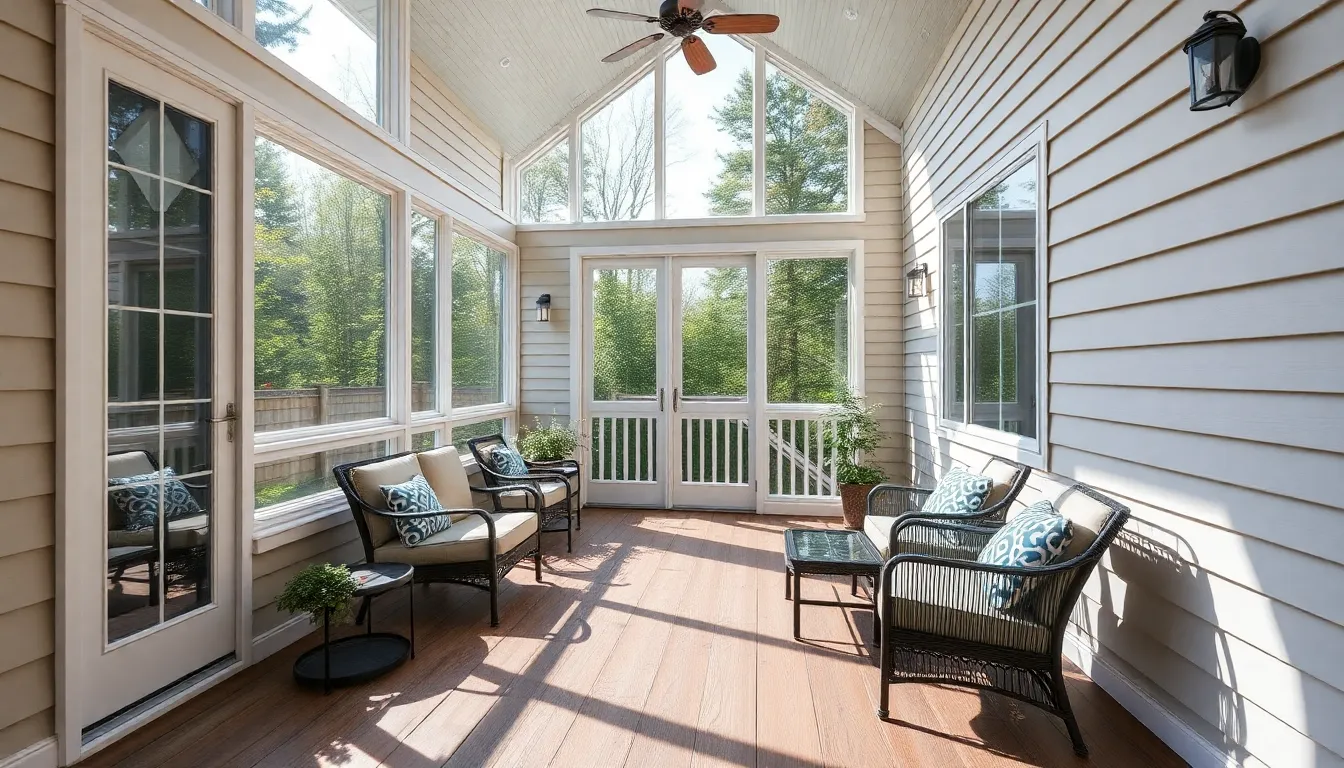
Durable materials form the foundation of every successful closed in back porch project. We’ll focus on elements that resist outdoor wear and tear while maintaining their appearance over time.
Choose Weather-Resistant Flooring Options
Flooring selection directly impacts your porch’s longevity and functionality. We recommend porcelain tiles as they handle moisture and temperature fluctuations exceptionally well. Natural stone provides another excellent option that withstands harsh weather conditions while adding timeless elegance to your space.
Weather-resistant composite decking offers superior durability compared to traditional wood options. These materials resist moisture damage and maintain their appearance through seasonal changes. Slip resistance becomes crucial for safety, especially during wet conditions.
Easy cleaning capabilities make these flooring choices practical for year-round use. Temperature variations won’t cause cracking or warping with properly selected materials. Installation quality determines how well your flooring performs over decades of use.
Pick Low-Maintenance Wall Treatments
Wall treatments require materials that resist moisture and pests effectively. We suggest vinyl siding for its exceptional durability and minimal maintenance requirements. Fiber cement panels provide another robust option that handles weather exposure without frequent upkeep.
Treated wood offers natural beauty while resisting decay and insect damage. These finishes reduce the need for constant repairs or repainting cycles. Protection from the elements extends the life of your investment significantly.
Resistance to fading ensures your walls maintain their attractive appearance over time. Minimal upkeep translates to lower long term costs and less hassle for homeowners. Quality materials prevent moisture infiltration that can cause structural damage.
Install Quality Windows and Doors
High-quality windows and doors create the barrier between indoor comfort and outdoor elements. We recommend investing in energy-efficient, double-paned options that provide excellent insulation properties. Weather-tight installation prevents drafts and water intrusion that can damage your enclosed space.
Proper ventilation capabilities allow you to control airflow when desired. Double paned construction improves temperature regulation throughout different seasons. Energy efficiency reduces heating and cooling costs while maintaining comfort levels.
Installation expertise determines how effectively these components protect your space. Water intrusion prevention extends the usability of your porch through various weather conditions. Quality components ensure your enclosed porch remains functional and comfortable year-round.
Maximize Natural Light and Ventilation
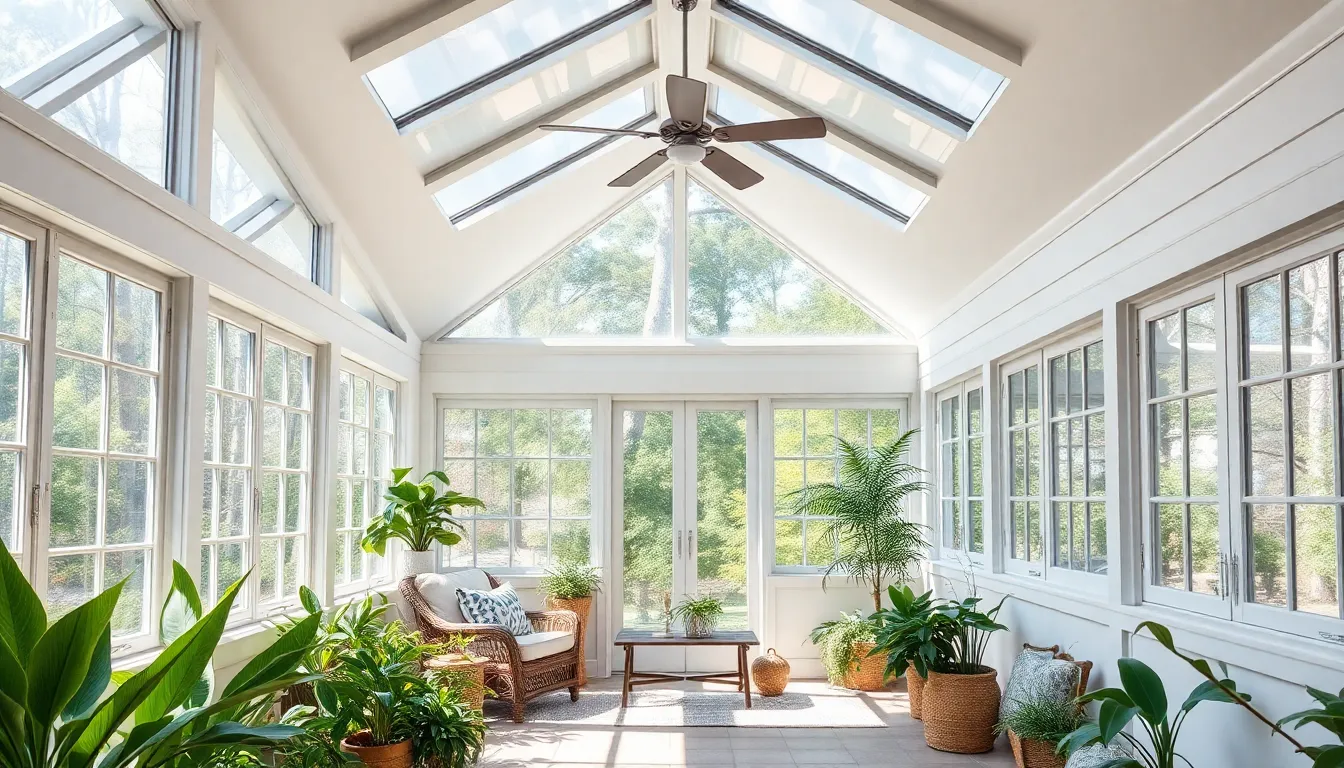
Natural light and proper airflow transform your enclosed back porch into a bright, comfortable retreat that feels connected to the outdoors. Strategic design choices can dramatically improve the space’s functionality and appeal year-round.
Add Skylights for Overhead Illumination
Skylights flood your enclosed porch with natural light from above, creating a bright and airy atmosphere throughout the day. We recommend installing operable skylights that not only provide illumination but also serve as escape routes for warm air, improving ventilation naturally. These overhead windows make the space feel larger and more open while adding architectural interest to your porch design.
Position skylights strategically to maximize light distribution during different times of day. Consider the sun’s path and your porch’s orientation when planning placement. Operable models allow you to control both light and ventilation, making them ideal for maintaining comfortable temperatures.
Install Operable Windows for Cross-Ventilation
Multiple operable windows on different walls create effective cross-ventilation that keeps your enclosed porch cool and fresh. Casement and awning windows work particularly well because they open wide, promoting maximum airflow through the space. Strategic placement of these windows reduces humidity and prevents stuffiness that can make enclosed spaces uncomfortable.
Plan your window layout to capture prevailing breezes in your area. Position intake windows on the side where cool air enters and exhaust windows on the opposite side. This creates a natural air circulation pattern that maintains comfort without relying heavily on mechanical systems.
Use Light Colors to Reflect Natural Light
Light colored paint on walls, ceilings, and trim reflects sunlight deeper into your enclosed porch, amplifying the brightness from windows and skylights. Whites, creams, and soft pastels work best for maximizing light reflection and creating an open, welcoming atmosphere. Light colored flooring and furnishings further enhance this effect by bouncing illumination throughout the space.
Choose paint finishes that complement your lighting goals while maintaining durability. Semi-gloss and satin finishes reflect more light than flat paints, making them excellent choices for porch walls. Coordinate your color scheme with existing home interiors to create seamless flow between spaces.
Incorporate Outdoor Elements for Seamless Transition
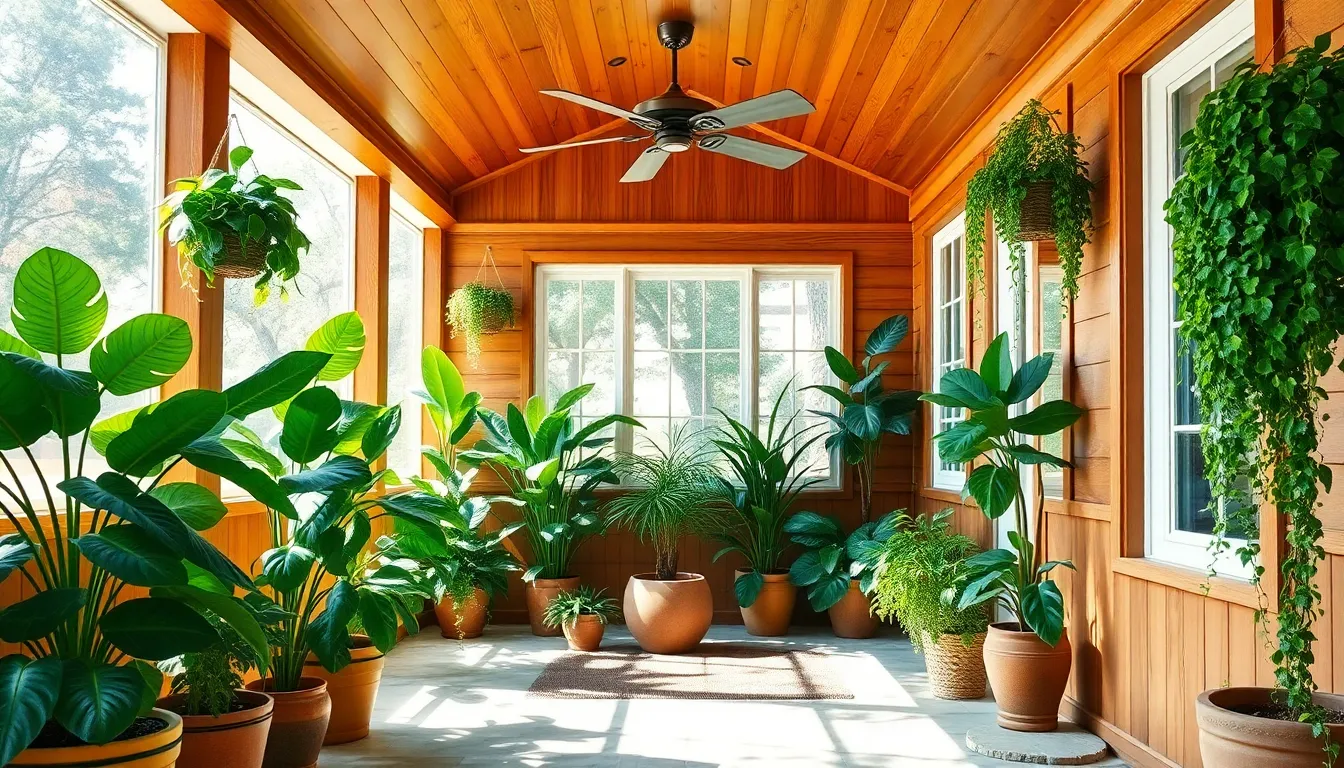
Creating an authentic outdoor atmosphere within your closed in back porch requires thoughtful integration of natural elements that blur the boundaries between inside and outside spaces.
Add Potted Plants and Greenery
Bringing nature indoors transforms your enclosed porch into a vibrant garden sanctuary. Large potted plants like fiddle leaf figs and monstera deliciosa create dramatic focal points while requiring minimal maintenance. Hanging baskets filled with trailing ivy or pothos add vertical interest and soften hard architectural lines.
Grouping plants at different heights creates visual depth and mimics natural garden arrangements. We recommend positioning tall floor plants like bamboo palms in corners, medium-sized plants such as snake plants on plant stands, and small succulents on side tables. This layered approach establishes a lush atmosphere that feels authentically outdoors.
Seasonal plant rotations keep your space feeling fresh throughout the year. Spring bulbs like tulips and daffodils brighten winter months, while heat-loving plants such as hibiscus and bougainvillea thrive during summer. Consider installing grow lights to support plant health during darker months.
Use Natural Materials Like Stone and Wood
Natural materials create an organic foundation that connects your porch to the surrounding industry. Wood paneling on walls and ceilings brings warmth and texture while complementing outdoor surroundings. Cedar and teak offer excellent moisture resistance for enclosed porch environments.
Stone accents on floors and feature walls establish a strong connection to natural elements. Flagstone tiles, river rock mosaics, and stacked stone create visual interest while providing durability. These materials work particularly well around fireplace surrounds and accent walls.
Combining different natural textures adds depth and authenticity to your design. Pair rough-hewn wooden beams with smooth river rock flooring, or contrast polished granite countertops with reclaimed barn wood shelving. This variety creates visual interest while maintaining the outdoor aesthetic.
Install Ceiling Fans for Air Circulation
Proper air circulation ensures your enclosed porch remains comfortable during all seasons. Ceiling fans reduce humidity levels and prevent stagnant air that can damage furniture and create uncomfortable conditions. We recommend fans with at least 52-inch blade spans for optimal air movement in most porch spaces.
Strategic fan placement maximizes airflow throughout the entire enclosed area. Position fans in the center of seating areas and dining spaces to ensure even air distribution. Multiple smaller fans often work better than one large unit in rectangular or L-shaped porches.
Energy-efficient fans with reversible motors provide year-round functionality. Summer operation pulls hot air upward while winter settings push warm air down from the ceiling. Look for ENERGY STAR certified models that consume 75% less energy than conventional fans while providing superior performance.
Conclusion
Transforming your back porch into a closed-in sanctuary opens up endless possibilities for expanding your living space. Whether you’re dreaming of a sun-drenched reading nook or a fully functional home office these ideas prove that with thoughtful planning you can create something truly special.
The key lies in choosing the right materials and considering your family’s exact needs. From proper insulation and climate control to durable flooring and strategic lighting every element works together to ensure your new space remains comfortable and functional year-round.
We’ve shown you how one enclosed porch can serve multiple purposes – adapting to your lifestyle as it evolves. With smart design choices and quality materials your closed-in back porch will become a valuable addition that enhances both your daily life and your home’s overall appeal.
Frequently Asked Questions
What are the main benefits of converting a back porch into an enclosed space?
Converting a back porch into an enclosed space provides year-round usability, increases home value, and creates versatile living areas. The enclosed space can serve multiple purposes like a home office, reading nook, dining area, or family room, maximizing your home’s potential while protecting you from weather elements.
What type of windows work best for an enclosed back porch?
Double or triple-pane windows are ideal for enclosed back porches as they provide excellent energy efficiency and insulation. Floor-to-ceiling windows maximize natural light and create an airy atmosphere. Consider operable skylights and multiple windows strategically placed to enhance cross-ventilation and capture natural breezes.
How can I create a functional home office in my enclosed back porch?
Position a custom desk near large windows to harness natural light, ensure proper electrical outlets, and incorporate diverse storage solutions. Integrate the office design with your home’s existing style, maintain adequate lighting with adjustable LED lamps, and keep the space organized for optimal productivity.
What flooring options work best for enclosed back porches?
Weather-resistant flooring like porcelain tiles, composite decking, and insulated vinyl planks are excellent choices. These materials withstand moisture and temperature fluctuations while providing durability. Consider adding area rugs for extra warmth and comfort, especially in colder seasons.
How do I ensure proper climate control in my enclosed back porch?
Install energy-efficient heating and cooling systems like heat pumps or ductless mini-split units. Ensure proper insulation, weatherproofing, and moisture control through effective sealing techniques and drainage systems. Natural ventilation through operable windows and ceiling fans also helps maintain comfortable temperatures year-round.
What furniture works best for enclosed back porch spaces?
Choose weather-resistant furniture made from treated wood, synthetic wicker, or materials with weather-resistant fabrics. Modular sofas and foldable chairs offer flexibility for different activities. Oversized armchairs with ottomans work great for reading nooks, while versatile pieces maximize functionality in multi-purpose spaces.
How can I maximize natural light in my enclosed back porch?
Use light colors for walls and furnishings to reflect natural light, install floor-to-ceiling windows, and consider operable skylights. Strategic window placement captures maximum daylight while maintaining proper ventilation. Combine natural light with adjustable LED lighting for optimal illumination throughout the day.
What storage solutions work best for enclosed back porch projects?
Built-in storage solutions like floor-to-ceiling custom bookshelves, media storage units, and craft supply organizers maximize space efficiency. Consider work surfaces at different heights for various activities and incorporate diverse storage options that maintain a clean aesthetic while keeping items organized and accessible.

